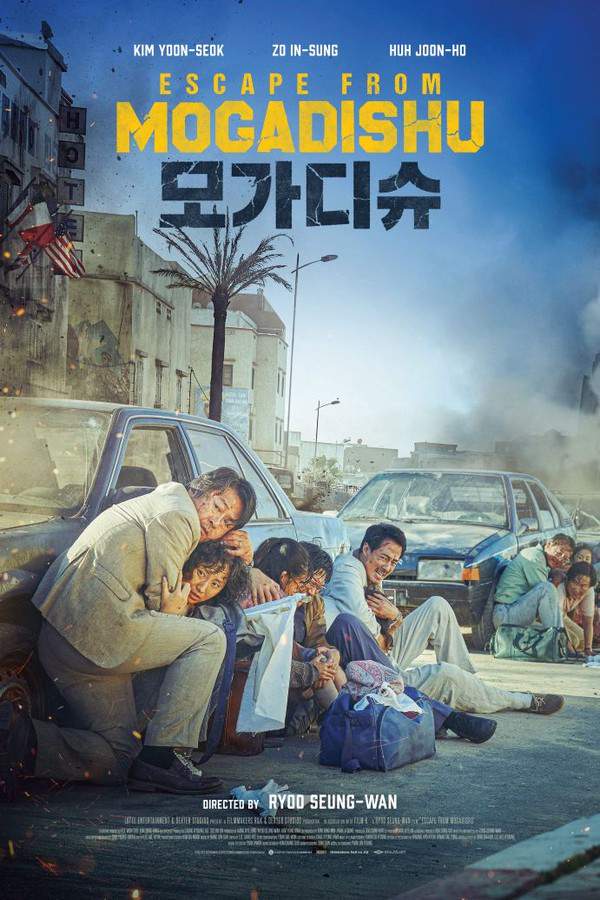
Hijack '93 Plot Summary
Read the complete plot summary and ending explained for Hijack '93 (2024). From turning points to emotional moments, uncover what really happened and why it matters.
The film begins with four key figures from the Movement for the Actualization of Democracy, each portraying a distinct character: Nnamdi Agbo as Skipper, Adam Garba as Eruku, Allison Emmanuel as Owiwi, and Oluwaseyi Akinsola as Iku, who embody Richard Ajibola Ogunderu, Kabir Adenuga, Benneth Oluwadaisi, and Kenny Razak-Lawal, respectively. Their journey begins as they drive towards the bustling Lagos International Airport, ready to board a Nigerian Airways Airbus A310. This seemingly routine flight is piloted by Captain Ambrose and Captain Odion, and is scheduled to take off on October 25, 1993, destined for Abuja. Among the passengers are a mix of prominent government officials, influential businesspeople, and everyday citizens, all blissfully unaware of the imminent threat lurking within their midst. Adding to the tension is the fact that a member of the cabin crew has already stashed weapons and ammunition in the airplane’s washroom, setting the stage for chaos.
Just moments after takeoff, the atmosphere shifts alarmingly as the four armed hijackers—Kayode, Owiwi, Omar, and Skipper—assert control of the aircraft with a chilling announcement: > “Ladies and gentlemen, this plane has been taken over by MAD Men; Movement for the Actualization of Democracy… MAD… Remain calm; we will not harm you. You will be informed of where the plane will land.” As they brandish their weapons with a chilling nonchalance, panic ripples through the cabin. Their demands grow more audacious by the second, as they call for the pilot to redirect the aircraft’s course to Frankfurt, Germany. The hijackers, fueled by a potent mix of political fervor, articulate their motives clearly: the resignation of General Sani Abacha, Nigeria’s Defense Minister, and an end to the rampant corruption and egregious human rights violations in the country, forcing a global audience to reckon with Nigeria’s tumultuous political landscape.
As the aircraft finally lands in Niamey due to critically low fuel, the situation escalates. Negotiations unfold between the hijackers, local authorities, and representatives from the Nigerian government, with each minute spent escalating the tension in the air. The hijacking rapidly captures the attention of international news networks, broadcasting the tense standoff to millions worldwide.
The clock is ticking, and the atmosphere on board grows increasingly fraught as authorities gear up for a high-stakes rescue operation, collaborating closely with Nigerian security forces in an attempt to navigate this perilous situation. As night sets in, Owiwi, in a fit of rage, threatens to take a life if his demands are not met, even as the hostages collectively fear that he might not carry through with the threat. Taking charge of the unfolding drama is Captain Kenneth Dokunbo, the commander of the special forces, who enters the fray with a purpose. A crucial twist emerges when it’s revealed that the son of the Chinese Ambassador to Nigeria, Lee Zhang, is also among the passengers. Aware of the potential fallout, the commander faces a dilemma: execute a rescue mission that could save the hostages but puts the lives of others, including Rong Yiren, the Chinese vice president, at risk.
Ultimately, in a glimmer of hope, the hijackers begin releasing women and children, a move that suggests they might be reconsidering their stance and are open to negotiations—if only their demands are taken seriously. As the emotional stakes grow ever higher, the world watches and waits, caught in the tension of a situation that could turn deadly at any moment.
Hijack '93 Timeline
Follow the complete movie timeline of Hijack '93 (2024) with every major event in chronological order. Great for understanding complex plots and story progression.
Departure from Lagos
The film begins with four members of the Movement for the Actualization of Democracy arriving at Lagos International Airport. They board a Nigerian Airways Airbus A310, piloted by Captain Ambrose and Captain Odion, preparing for a routine flight to Abuja scheduled for October 25, 1993.
Takeoff
After a brief wait, the aircraft takes off from Lagos, carrying a diverse group of passengers, including prominent government officials and regular citizens. Unbeknownst to the passengers, one of the cabin crew members has hidden weapons in the washroom, setting the stage for the upcoming crisis.
Hijacking Begins
Shortly after takeoff, the four armed teenagers—Kayode, Owiwi, Omar, and Skipper—take control of the aircraft. They announce their presence as members of the MAD Men, demanding the pilot redirect the flight to Frankfurt, Germany, while assuring passengers they mean no harm.
Demands Made
The hijackers quickly escalate tensions by revealing their motivations behind the hijacking. They demand the resignation of General Sani Abacha and insist on an end to government corruption and human rights abuses in Nigeria, thus drawing attention to the nation's political unrest.
Descent into Niamey
As fuel levels drop, the aircraft lands in Niamey, Niger. This unexpected landing prompts a series of negotiations between the hijackers, local authorities, and representatives from the Nigerian government, highlighting the international implications of the incident.
International Attention
News of the hijacking spreads across the globe, capturing the attention of major news networks. The unfolding crisis is broadcasted worldwide, as people become increasingly aware of the dire situation on the aircraft.
Tensions Escalate
As negotiations progress, the atmosphere on the plane becomes increasingly volatile. Owiwi loses his temper, threatening to kill a passenger to demonstrate the seriousness of their demands, even though the hijackers are aware they must tread carefully.
Rescue Operation Preparations
As night falls, the Nigerian security forces prepare for a risky rescue operation, coordinating efforts to resolve the ongoing standoff. The presence of key passengers, including the son of the Chinese Ambassador, complicates their strategy, as they can’t afford to jeopardize any lives.
Negotiations Continue
During the ongoing crisis, there are continued efforts to negotiate the safe release of hostages, particularly focusing on resolving the demands laid out by the hijackers. Authorities work tirelessly to ensure the safety of all passengers on board.
Release of Women and Children
In a surprising turn, the hijackers agree to release women and children onboard the flight. This act hints at their willingness to negotiate, and serves as a pivotal moment in the standoff, raising hopes for a peaceful resolution.
Final Negotiations
With the release of the vulnerable hostages, talks intensify as the hijackers outline their remaining demands. Local and international authorities make a concerted effort to find a diplomatic solution that would satisfy both the hijackers and ensure the safety of the remaining passengers.
Critical Decision Point
As tensions reach a boiling point, the situation evolves into a critical decision-making scenario for security forces. The risk of an impending rescue mission looms large, with lives hanging in the balance amid escalating threats from the hijackers.
Legacy of the Hijacking
In the aftermath of the hijacking incident, the actions of the MAD Men force a global audience to confront the political turmoil in Nigeria, raising questions about governance, human rights, and corruption. The event casts a long shadow on the future of democracy in the region.
Hijack '93 Characters
Explore all characters from Hijack '93 (2024). Get detailed profiles with their roles, arcs, and key relationships explained.
Nnamdi Agbo as Skipper
Skipper serves as a key figure among the hijackers, embodying youthful defiance and a strong sense of purpose. His character reflects the struggles of a generation seeking to effect change in a corrupt political landscape, though his choices lead to devastating consequences for many.
Allison Emmanuel as Owiwi
Owiwi is portrayed as volatile and impulsive, with a temper that escalates the stakes during the hijacking. His character’s emotional volatility adds tension to the narrative, highlighting the internal struggles faced by individuals in the heat of such a high-pressure situation.
Oluwaseyi Akinsola as Iku
Iku represents a quieter yet impactful voice among the hijackers, showcasing a more calculated approach to their cause. His character contributes to the complexity of the group dynamic, balancing between aggression and strategy as they navigate their demands.
Kabir Adenuga as Eruku
Eruku adds another layer to the hijacking crew, displaying loyalty to the group's cause while grappling with moral dilemmas. His character's journey reflects the internal conflicts faced by those involved in radical actions for a perceived greater good.
Hijack '93 Settings
Learn where and when Hijack '93 (2024) takes place. Explore the film’s settings, era, and how they shape the narrative.
Time period
1993
The events occur during a politically turbulent period in Nigeria, specifically in October 1993 when the country faced a struggle for democracy against military rule. This time was marked by widespread corruption, human rights abuses, and public unrest, which fueled the motivations of the hijackers to make their demands known to the world.
Location
Lagos, Abuja, Niamey, Frankfurt
The movie takes place across several significant locations, starting in Lagos, Nigeria's bustling commercial capital, known for its energetic atmosphere and cultural diversity. The journey extends to Abuja, the country's political center, and Niamey, the capital of Niger, where critical negotiations unfold. Frankfurt is mentioned as a target destination, representing a place tied to the hijackers' demands.
Hijack '93 Themes
Discover the main themes in Hijack '93 (2024). Analyze the deeper meanings, emotional layers, and social commentary behind the film.
✊
Activism
The film highlights themes of political activism wherein the hijackers seek to draw attention to the corruption and injustices in Nigeria. Their actions, framed as a desperate plea for political change, raise questions about the lengths individuals might go to in order to fight against oppression and seek democracy.
💔
Tension
Tension is a central theme throughout the movie as both hostages and hijackers navigate their precarious situation. The atmosphere shifts dramatically from calm to panic, revealing human emotions during crisis and the fragile nature of life under threats of violence and coercion.
📺
Media Attention
The hijacking receives considerable media coverage, illustrating the role of news networks in shaping public perceptions of crisis. The global broadcast of the events places additional pressure on the hijackers and highlights how politics can become a spectacle in the face of human lives at stake.
Hijack '93 Ending Explained
Unravel the ending of Hijack '93 (2024) with our detailed explanation. Understand the final scenes, character fates, and unresolved questions.
In the end, the hijackers are captured by the Nigerian Special Forces after a tense confrontation. They are eventually tried in Niger, just as they demanded, and serve a nine-year sentence. What makes this conclusion powerful is that the hijackers’ motives are truly revealed—they weren’t driven by greed or malice, but by desperation rooted in Nigeria’s corrupt and unjust system. Their act of hijacking was a cry for justice, a desperate attempt to highlight the widespread social inequality and government corruption that had left them with no other options. During the rescue, the authorities carefully avoid harming the son of the Chinese ambassador, Lee Zhang, by poisoning his food to make him sick and prevent a risky military raid. The hijackers ultimately release the women and children, and they are willing to surrender when their demands are met. Their goal wasn’t material gain but to be heard and understood, to bring international attention to the injustices faced by their countrymen. The story concludes with the hijackers being convicted and serving time, but more importantly, having succeeded in exposing the dire social issues facing Nigeria. The film’s ending leaves the audience with a poignant reminder that sometimes extreme actions are rooted in a desire for justice, and that desperate circumstances can push even the most unlikely individuals to such lengths. Ultimately, it’s a story about the power of voice and the tragic consequences of neglect and corruption.
Movies with Similar Twists and Themes
Uncover films that echo the narrative beats, emotional arcs, or dramatic twists of the one you're exploring. These recommendations are handpicked based on story depth, thematic resonance, and spoiler-worthy moments — perfect for fans who crave more of the same intrigue.
Featured on this page

What's After the Movie?
Not sure whether to stay after the credits? Find out!
Explore Our Movie Platform
New Movie Releases (2025)
Famous Movie Actors
Top Film Production Studios
Movie Plot Summaries & Endings
Major Movie Awards & Winners
Best Concert Films & Music Documentaries
© 2025 What's After the Movie. All rights reserved.












